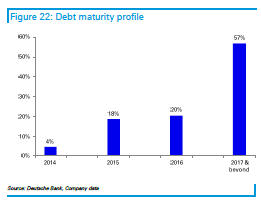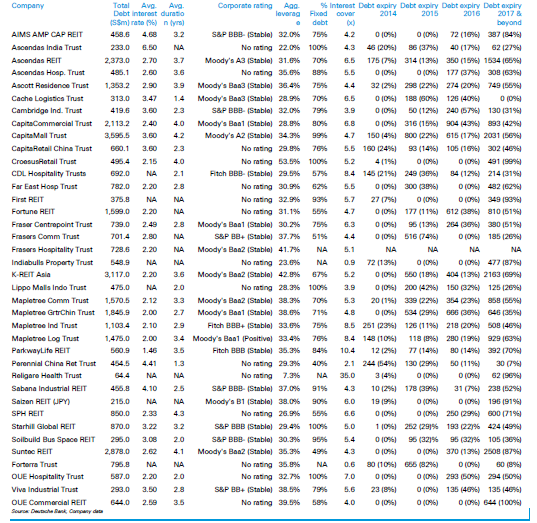Real Estate Investment Trust (REIT) is one of the most popular investment tools for investors looking for stable income distribution. In a typical REIT structure, money is raised from unitholders through an IPO at the initial stage and is used by the company to purchase a pool of real estate properties. These properties are then leased out to tenants and in return, the income flows back to the unitholders as income distributions (dividends).
Due to the way they are structured to form tax benefits to the company, REITS are required to distribute at least 90% of taxable income each year to enjoy the tax exempt status by the tax authority. Because of this rule, REITS company usually retained very little earnings to fund their next expansion plan, either organicly through an Asset Enhancement Initiative (AEI) or inorganicly through an acquisition. This is made worse if the REIT company distributes all 100% of the income distribution to shareholders, which is usually very common the case these days since there are huge pressure from shareholders to the management to focus on the DPU.
For example, based on the latest announced results, many REITS companies such as FCOT, FCT and LMIRT distribute the full 100% of the dividend earnings to shareholders while companies like PLIFE retained at least $3m per annum for CAPEX purpose to maintain its existing properties.
The problem with distributing the full earnings back to shareholders without retaining any for themselves means that any further expansion either organic or inorganic will need to be funded via debt or equity.
Funding the expansion via placement or rights issue through the direct equity method are usually unpopular and they are often much costly than funding via debt due to the nature of their cost of capital. Hence, management would always look to debt first when raising funds especially in the current low interest rate environment we have undergone for the past 6 years. The risk is of course when interest rates start to rise and they are not able to refinance back in time. But a good management would be able to hedge the risk through fixed rate borrowings, which is what a lot of management is doing these days.

Gearing
Many investors put gearing requirement as one of the top checklist when selecting a REIT to invest. Since they are so important, we will take a look at a closer detail.
The thing about gearing is it is measured debt over equity. Since equity earnings in the form of retained profits are almost non-existent based on what we have seen earlier, the only way the company can raise funds for acquisition without increasing the number of outstanding shares is through debt.
Maximizing the efficiency of leveraging is a form of management competency. On one hand, it can increase the return on equity of a company when planned well. On the other hand, it may threaten the existence of the company when it backfires.
Hence, these should be the focus for investors to look at when we are specifically talking about debt in general:
1.) Refinancing of Loans
Since the incident revolving the GFC in 2008, many REITS companies have strengthened their position and refinancing capability to avoid repeats of such incidents. They are better shaped to weather the difficult conditions and stronger REITS have management that can get better deals on refinancing their loans. I think there’s many companies now that have stressed the importance on this given the lesson learnt back then.


Furthermore, we can see that on average the majority of the loans have been refinanced to 2017 and beyond. I think the management has prudently done their due diligence and hedge some risks by doing so.
We should also look at the interest coverage ratio to see how well is the company covered in case macroeconomic event threatens such as interest rate increases.
2.) Revaluation of Assets
This is something which many investors have overlooked but is important.
The recent IAS40 implemented has allowed companies to record their investment properties at fair value by recognizing the gains/losses at its carrying value. Through upward revaluation or impairment of assets, companies can have a smaller or larger base on their equity portion, which directly affects gearing level to increase or decrease.
The physical structure on a property is a depreciating asset. As it ages, it requires capital infusions for regular maintenance, functional obsolescence and many other things you can think of. Because of this reason, the loss to impairments are likely to occur more than the upside revaluation in general.
For an upward revaluation of assets for REITS, investors will need to consider the following factors:
i. Tenure of Land Lease
I was discussing this with SRSI not too long ago.
The tenure of the land lease provides an indication of future reasonable cash flow since independent valuers like Collyers did a DDM over 10 year period to arrive at their valuation.
For asset properties for FCT, Causeway point and Northpoint are a 99 years leasehold with 80 and 75 years remaining. Changi City Point is only a 60 years leasehold with 55 years remaining.

We see REITS like OUE Commercial or MGCCT which has property exposures in China which usually has a much shorter land lease than other countries for the same commercial use. They are left with some 30+ years before the rights to land use expiry.
The key is to note these leases expiry and do a comparable review among peers to see if they are worth the valuation or warrant any future upside to the property.
ii. Future Development Prospects
Investors must also be cognizant that not only the present state of the current development, but also the future prospects which will be developed in the area.
Again, using the FCT example, we know there are initiatives from the URA Master Plan 2014 to develop the Woodlands Regional Center into a major commercial hub as well as the expansion of Changi Business Park. Yishun is also expected to be rejuvenated, with upcoming major future developments such as Northpoint City, an integrated mixed use development with an air-conditioned bus interchange, residences, retail and a community club.

These will directly bring positive impact to the attractiveness of the asset as they will generate more returns per visitors which brings higher valuation to the asset itself.
Conclusion
This is not meant to be a long-winded post but it is always good to think about the rationale behind the ratio and which factors you deemed as more important than the others.
Everyone knows the importance of gearing but little do know how other things are impacting the gearing which are not so evident at face value in the financial statement.
With Singapore being a REIT friendly environment to raise capital, we will probably see more REITS getting listed in the years ahead, and with more considerable comparison we can choose from, we definitely have a feast in the coming years ahead.


Hi B!
Its always good to sit back and enjoy your free lessons/analysis thru the internet. Ive just finished my rich dad poor dad book. Somehow ive lost interest in REITS and maybe starting to plan to inject my money into new ipos and wait for 'home runs'.. thats the only faster way for me to get richer.
I see that uve been repeatedly emphasized on my blog that i am a income lover. But i am considering, the gain is quite constant. Maybe i want to make big money and not just constant dividends from REITS.
whats your recommendation to me?
Curious. What did RDPD say that led you to the conclusion to go with IPOs? I didn't get that vibe when I read the book previously.
Hi,
Take a look at RDPD page 176 starting from last paragraph, than at somewhere on page 177 he said. "a great portfolio is for someone who loves safety, but playing it safe and balanced on your investment portfolio is not the way to successful investor get rich, u must be focused, not balanced"
in reflection of these, i think REITs is a stable income investment. and IPOs are risker and may close down anytime, but on the other hand it can also become a very successful one.
haha please correct me if i am wrong or misunderstood his statement wrongly :D:D:D:D
im trying but i can't find, i remember he mentioned in the book. he put his money in some new stocks, some of them were lost but he had a few home runs. out of 10 new stocks he bought 2 or 3 are home runs.
Hi jfree
It's totally fine to have a different strategy of not becoming an income investor. I think other strategy can work as well if they are executed properly.
What I think about those who only invested in IPO is they probably are the same people who will never learn anything about investing. Any new IPO comes in, they will subscribe in the hope of selling when the stock trades on the first day. On the lucky day, they can earn some 10 to 20% return and on some day they will lose. As a retail investor, hot IPOs are very hard to get and it is difficult to get rich just by subscribing to the IPO without having an understanding of how much the company is truly valued.
Just my 2 cents 🙂
HI B,
If I may just kaypo here.
I think it is important to recognize the % of foreign properties in the reit portfolio.
It will be exposed to currency risk (which is a no-brainer), and also taxation risk. I read somewhere that tax incentive for overseas
Oh here is the link: http://www.kpmg.com/SG/en/SingaporeBudget/budget2014/Pages/Is-the-path-ahead-bumpier-for-Singapore-listed-REITS-PR20140218.html
"However, in late 2000, an expiry date of 31 March 2015 – or the sunset clause – was introduced and caught the REIT market by surprise.
S-REITs that had structured their foreign property investments to obtain foreign income exemption now had to contend with the possibility of a less efficient tax structure after 31 March 2015.
If the foreign income exemption regime is not extended, the foreign income received by these S-REITs after 31 March 2015 will be subject to tax.
Personally, I do not view placement or rights as necessarily negative despite the dilution. However, it is important to see a clear pattern or track record of using placement for yield accretive buys and recycling of properties at good price (sell old building (at profits) to buy newer ones). I sometimes think these qualitative reasons are not given enough attention
Hi Sillyinvestor
Thanks very much for the article.
I knew about the Singapore tax restriction on exemption on foreign income but didn't know about the expiry tax scheme in 2015. That would be horrendous if that were to come true. Definitely an eye to keep out for.
I like REITs, but they're fairly expensive with the low interest rate environments. Oh wells.
Hi Henry
They certainly are and have been outperforming the whole index by quite a while now.
Hi B,
Reits is probably one of the most important dividend sector in SGX.
Everyone love to collect rents! But as you said, there is no retained earnings.
If lets say u r able to dictate the rulings. Will you decrease the dividend payout so that there is increase retain earnings for growth rather than taking debt?
Hi Rolf
I wouldn't necessarily change the rulings because otherwise they will just be an ordinary stock like those developers. I like how they are being set up and a good management will play a very important role even more so now that they retained very little earnings to keep on growing.
another well written post!
holding reits consisting of quality assets with good earning power is one of the safe ways to preserve value and enjoy cash income.
Hi Richard
Thanks for your comment.
I second to that 🙂
Hi B,
Very informative article about reits. I have never analyzed or studied reits deeply before and I must say I've learnt quite a bit from your writing. Perhaps I can start looking into some of their statements when I have the time 🙂
Thanks for the boost!